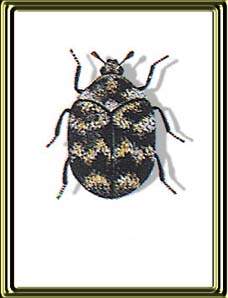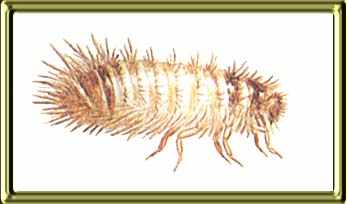
(Varied Carpet Beetle)
This species infests the usual range of household articles attacked by carpet beetles, such as carpets, woolen goods, silks, skins, furs, feathers, hair, horn, cereals, red pepper, fishmeal, or any processed animal or plant food. However, the favored larval foods are dead insects and spiders, which may account for the frequent occurrence of the varied carpet beetle in insect collections in museums. In common with other carpet beetles, this species will feed on cottons, linens, and synthetic fibers if they are contaminated, but it will not feed on rayon acetate. In California, the varied carpet beetle is the most injurious fabric feeding dermestid, and its prevalence has been attributed to the wasp nests around homes, which these beetles also infest. The adult carpet beetle feeds only on pollen and nectar of garden flowers but lays its eggs in old birds' nests, felt, fabric or accumulated fluff in buildings.Description:
This species has a number of varieties. They differ in shape, size, color, and pattern of the scales, but in general the adults are 2 to 3 mm long, and have a varied pattern of white, brownish, and yellowish scales on the back and fine, long, grayish-yellow scales below. Where the elytra terminate, they do not form a cleft as do those of the furniture carpet beetle, A. flavipes. The mature larva is 4 to 5 mm long, and has a series of light- and dark-brown transverse stripes. If it is suddenly alarmed, the larva erects the 3 dense tufts of bristles and hair located on each side of the rear end of the body, spreading them out to form beautiful, round plumes. The larvae (known as wolly bears) are broadest near the rear, and becomes narrower toward the front end, unlike other carpet beetles.

Life Cycle:
The female lays about 40 eggs. There are usually 7 to 8 larval instars, but the number may vary from 5 to 16. The numbers of days for the various stages are as follows: egg, 17 to 18; larva, 222 to 323; and pupa, 10 to 30. The period from egg to adult is 249 to 354 days, and the adult may live another 14 to 44 days.
Back to main Textile Pests Page